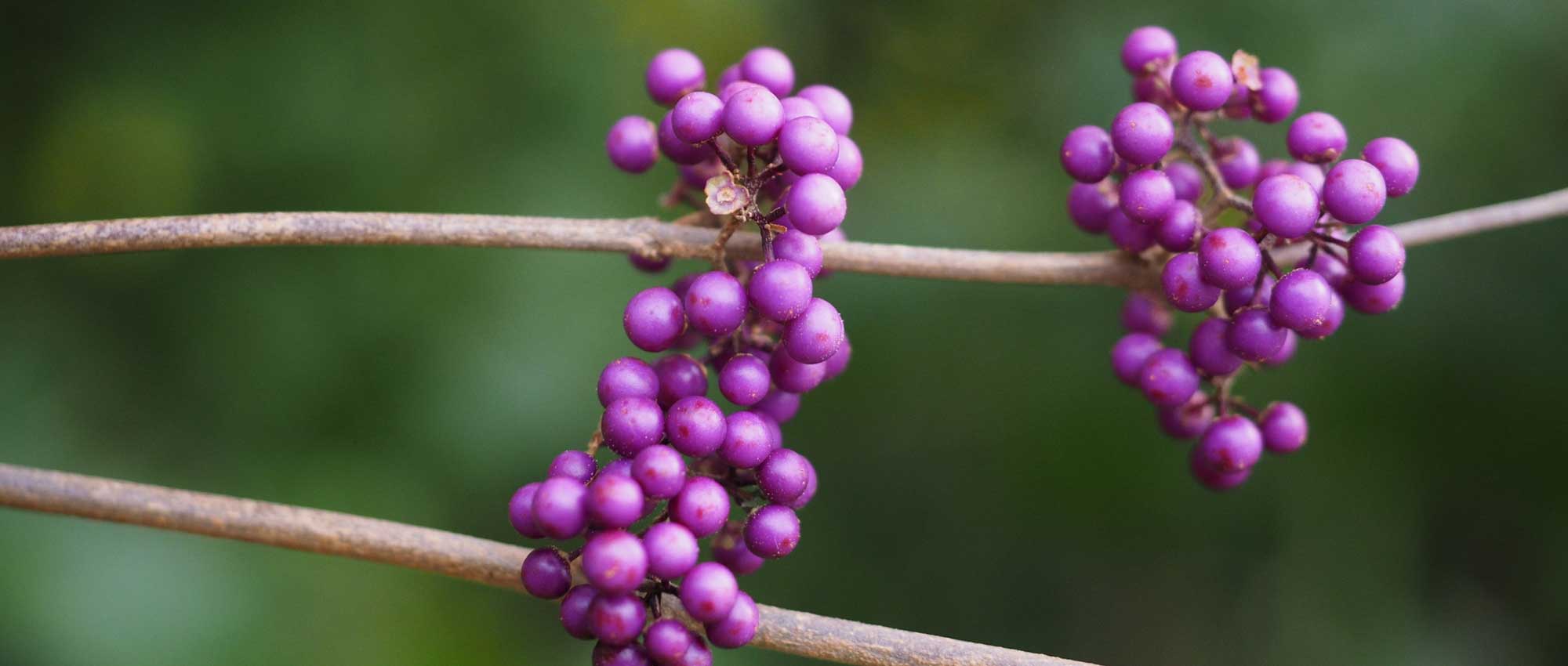
Callicarpa, beautyberry : planting, growing and care
Contents
Callicarpa in a nutshell
- With its purple berries, Callicarpa is an unusual bush that brings colour and brightness in autumn!
- Easy to grow, it requires little maintenance! It is rarely attacked by diseases or pests.
- It has ordinary foliage, discreet flowers… but these are followed by spectacular fruiting!
- Its very natural appearance makes it an ideal bush for a country hedge or at the back of a flower bed.
- Although it is known for its purple fruits, there are also varieties with white berries.
- The foliage often takes on lovely colours in autumn!
A word from our Expert
Also known as the Candy Tree, Callicarpa is a stunning little bush that enlivens autumn with its surprising purple berries! Although the most common variety is Callicarpa bodinieri ‘Profusion’, there are many other species, such as Callicarpa japonica, Callicarpa americana, or Callicarpa dichotoma… At first glance, the callicarpa is quite an ordinary bush. Its foliage is simple, its flowers are pretty but discreet, and from a distance, they are not really noticeable… but they are followed by magnificent berries that bring colour in the heart of autumn! This is truly the season that this bush has chosen to reveal all its beauty, often with foliage that adorns itself in lovely golden, orange, or purple hues depending on the varieties. Its berries resemble pearls, round and shiny, with stunning shades, bringing vibrancy and brightness in autumn! You can use the branches covered in berries to incorporate them into bouquets!
The callicarpa is an easy bush to grow and maintain! It is never sick or attacked by pests. It thrives in the sun, in fresh, well-draining soil. You can plant it in a wild hedge or at the back of a flower bed, alongside other bushes with decorative berries or colourful autumn foliage. We recommend grouping several callicarpa plants together to encourage pollination, and thus fruiting. Pruning the callicarpa helps to give it a harmonious and compact shape, but it can also do perfectly well without it. It can be propagated by sowing or propagation by cuttings.
Botany
Botanical data
- Latin name Callicarpa sp.
- Family Lamiaceae
- Common name Candy bush, Bodinier's Callicarpa
- Flowering summer
- Height Up to 3 metres.
- Exposure Sun or partial shade.
- Soil type ordinary, but cool and well-drained.
- Hardiness Generally down to -15 °C. A bit less for some varieties.
The callicarpa are trees or bushes that mainly come from East Asia (China, Korea, Japan, Vietnam, Taiwan…). Thus, Callicarpa bodinieri comes from China and was introduced to France at the end of the 19th century. Other species of Callicarpa are native to North or South America, such as Callicarpa americana, which comes from the southeastern United States (Florida, Virginia, Louisiana, Texas…). There are even a few species in Australia and Madagascar! In the wild, callicarpa mainly grow in forests. Species from tropical forests are evergreen, while those we cultivate in our gardens, which come from temperate zones, are deciduous.
The callicarpa belongs to the family Lamiaceae. This is a large family that includes over 6,000 species of plants with simple, opposite leaves, often dentate, and irregular flowers… These are generally fragrant plants, widely used for their medicinal or aromatic properties, such as Sage, Mint, Thyme, or Lavender. There are also other ornamental bushes, such as Caryopteris or Clerodendron. The callicarpa was formerly classified among the Verbenaceae, the family of verbena and lantanas.
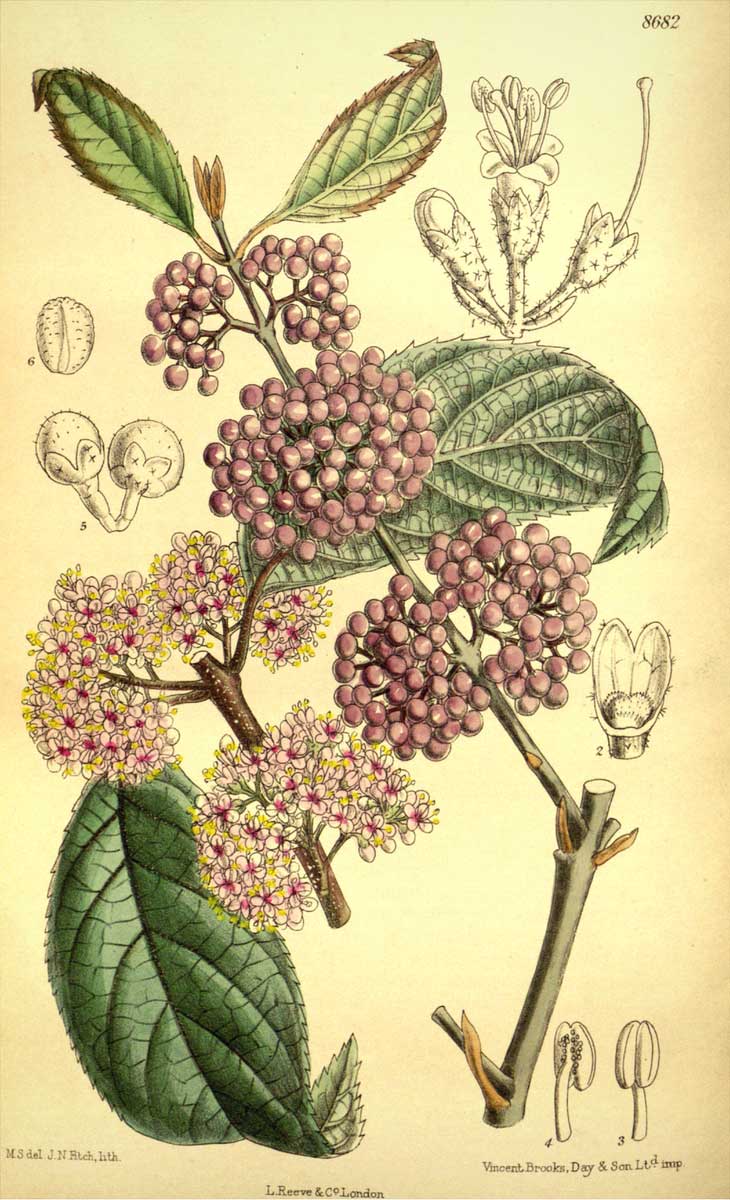
Callicarpa bodinieri: botanical plate
There are nearly 170 species of callicarpa. Despite this large number of species, only one variety is mainly found in garden centres, the Callicarpa bodinieri ‘Profusion’, which is much more widespread than all the others! This variety has been favoured because it offers a very generous fruiting and is quite robust, with good hardiness.
Etymologically, the callicarpa owes its name to the beauty of its berries: in Greek, kallos means beautiful, and karpos: fruit. In English, it is called BeautyBerry, which means the same thing, “pretty berries”. In French, it is also commonly referred to as “Candy bush”.
The callicarpa are shrubs that can reach up to three metres in height. Some are more compact, like the Callicarpa dichotoma ‘Issai’, which reaches about 1.20 m in height. Callicarpa often take quite irregular forms, measuring roughly the same in width as in height. Their branches are generally quite long and curved. This gives Callicarpa dichotoma its particularly elegant habit, with long pendulous branches. The stems of callicarpa are pubescent, covered with small hairs, just like the underside of the leaves.
The callicarpa bears quite discreet flowers in mid-summer, around July, sometimes hidden by the leaves. They are grouped in small dense cymes that generally measure three to four centimetres in diameter and are located in the axil of the leaves. The flowers are pretty but discreet… From a distance, they are not really noticeable. They consist of a corolla with four lobes (fused petals) often pale pink, surpassed by four long yellow stamens. The flowers are white in Callicarpa japonica ‘Leucocarpa’ (like the fruits). In other varieties, they can take on red or purple hues. Most callicarpa are hermaphrodites.
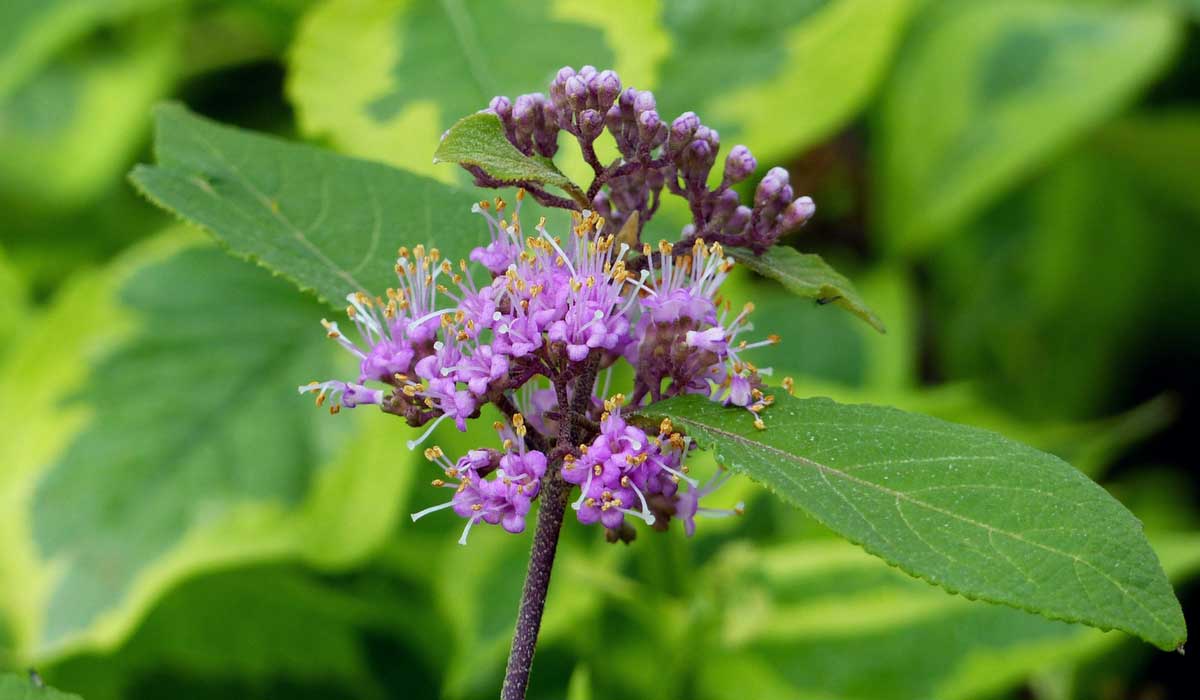
The flowering of Callicarpa bodinieri ‘Profusion’
In autumn, starting in October, the callicarpa impresses us with its bright, round berries, showcasing stunning colours! They resemble beads with metallic reflections. They are often pink or purple… except for the Callicarpa japonica ‘Leucocarpa’, which has white berries! They generally measure 3 to 4 mm in diameter. They are grouped around the branches in small dense clusters. They are tightly packed against the stems, as their peduncle is very short.
They are not edible, neither for us nor for birds, who, fortunately, leave them alone! They can thus remain on the shrub for a long time… generally until December! They stay in place after the leaves fall, allowing for good enjoyment. Each berry contains four small seeds. Sometimes they germinate spontaneously at the foot of the shrub.
The foliage of the callicarpa is quite ordinary. Like other Lamiaceae, the leaves are entire, simple, with dentate edges, and arranged oppositely on the branches. They bear small hairs on their underside.
However, the leaves of the callicarpa take on very beautiful colours in autumn! They adorn themselves with shades of yellow, orange, red, or purple. The foliage of Callicarpa rubella is remarkable as it turns pink in autumn, while that of Callicarpa japonica becomes golden with touches of violet! When at the end of the year it takes on bright hues, the foliage creates a superb contrast with the purple berries. Sometimes, it is the young leaves that are interesting for their colours, like those of Callicarpa bodinieri ‘Profusion’, tinted bronze. There is even a variety with marbled white foliage, Callicarpa japonica ‘Koshima-no-homate’, but it is quite rare in cultivation.
The callicarpa that we cultivate in our gardens are deciduous shrubs, which lose their leaves for winter, while there are other species, native to tropical regions, that are evergreen.
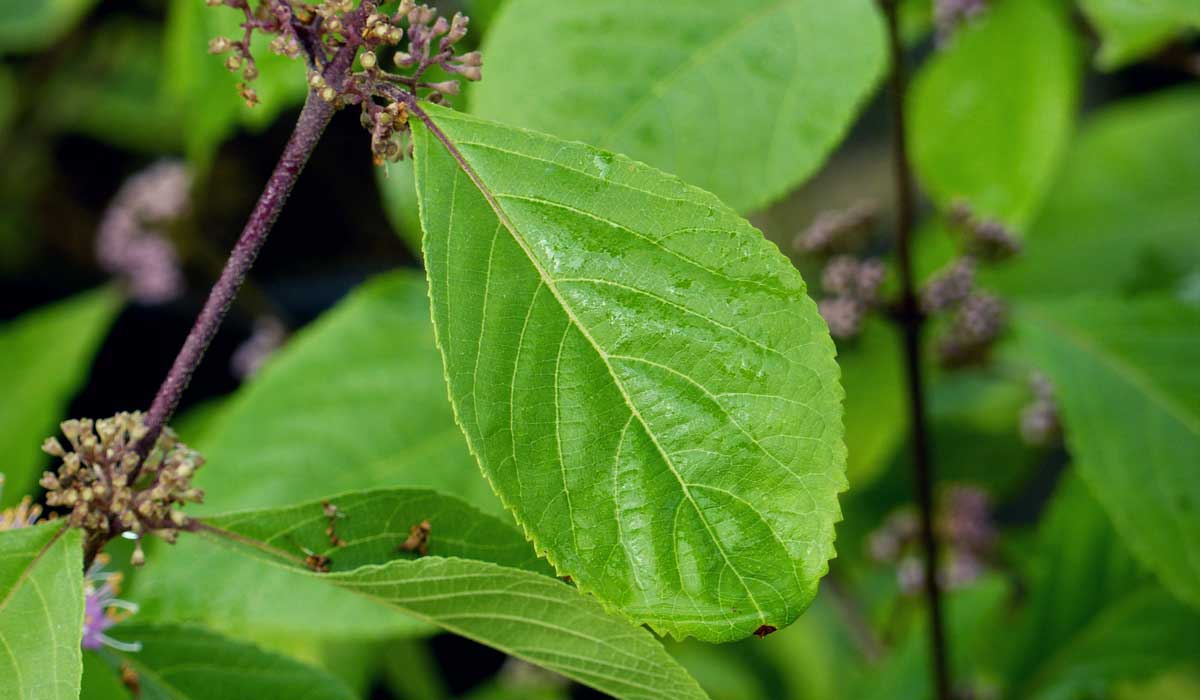
The foliage of Callicarpa bodinieri ‘Profusion’
The botanical species:
- Callicarpa bodinieri
This is by far the most cultivated of the callicarpa, especially with the variety ‘Profusion’! It is remarkable for its generous flowering and good hardiness. It comes from China and was introduced to France at the end of the 19th century.
- Callicarpa dichotoma
This is the most elegant callicarpa! It is not very tall, but has long pendulous branches that give it a particularly graceful habit. Its leaves turn red in autumn. It will need protection in the coldest regions, as it is more fragile than Callicarpa bodinieri ‘Profusion’.
- Callicarpa kwangtungensis
This callicarpa has pale pink flowers, followed by violet-pink berries. Its leaves, thinner and longer than those of other species, take on very beautiful colours.
- Callicarpa japonica
This is a fairly compact callicarpa, not exceeding 1.50 m in height. It takes on superb shades in autumn, its foliage becoming golden with hints of violet.
- Callicarpa americana
This species, native to the southeastern United States, has long pendulous branches like Callicarpa dichotoma, giving it a very elegant appearance. It bears pretty pink-purple berries in autumn.
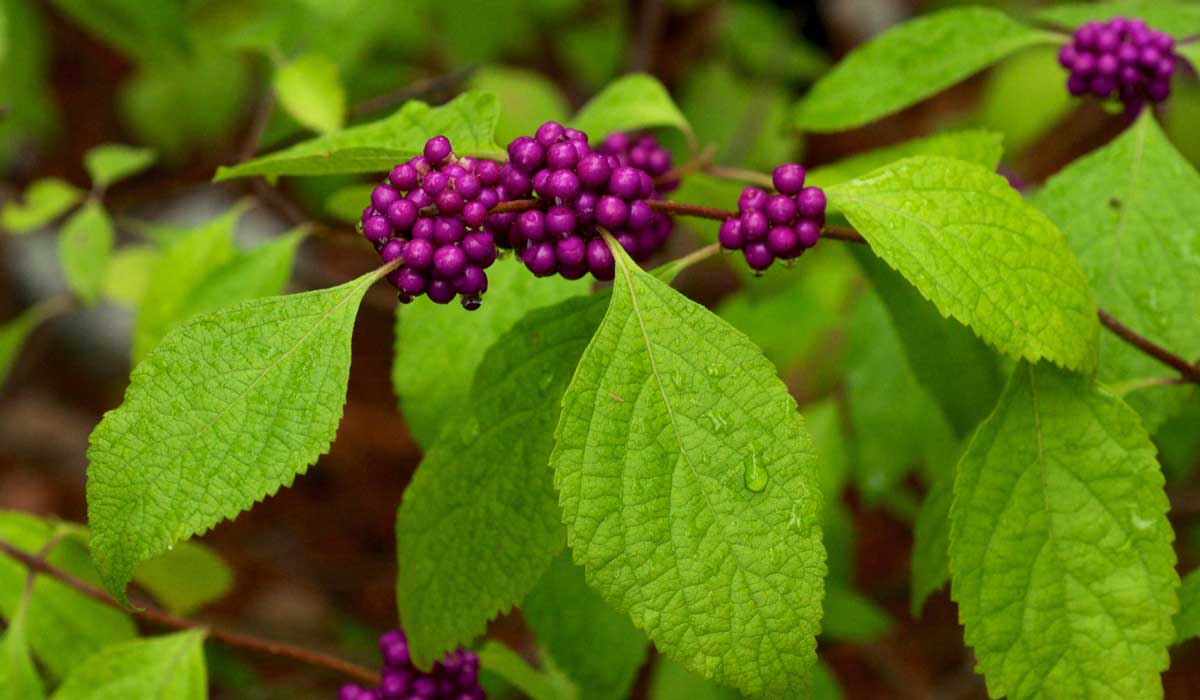
Callicarpa americana
The main varieties of Callicarpa
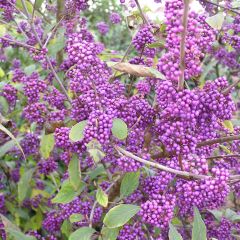
Callicarpa bodinieri var. giraldii Profusion
- Flowering time July to September
- Height at maturity 2,50 m
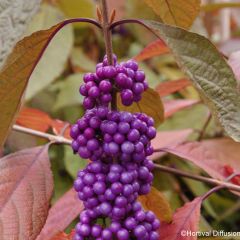
Callicarpa bodinieri Imperial Pearl
- Flowering time July to September
- Height at maturity 2 m
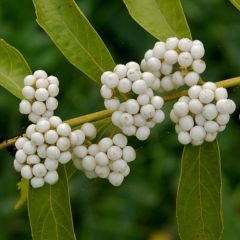
Callicarpa dichotoma Albibacca
- Flowering time July, August
- Height at maturity 1,40 m
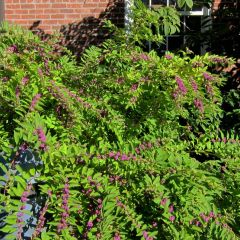
Callicarpa dichotoma Issai
- Flowering time July, August
- Height at maturity 1,25 m

Callicarpa kwangtungensis
- Flowering time August, September
- Height at maturity 1,50 m
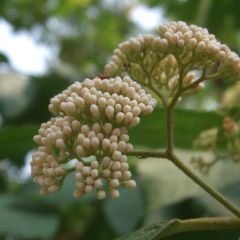
Callicarpa japonica Leucocarpa
- Flowering time September, October
- Height at maturity 1,50 m
Discover other Callicarpa
View all →Available in 0 sizes
Available in 2 sizes
Available in 2 sizes
Available in 4 sizes
Available in 1 sizes
Available in 1 sizes
Available in 1 sizes
Available in 1 sizes
Available in 1 sizes
Available in 1 sizes
Planting Callicarpa
Where to plant?
Plant your Callicarpa preferably in full sun. This will encourage fruiting. In the north of France, it is better to place it in full sun, while if you live in the south, partial shade will suit it very well! It tolerates slightly shaded situations as long as there is enough light, which is necessary for good flowering and fruiting.
It appreciates cool soils that do not dry out too much, even in the height of summer. It is advisable to install a layer of mulch at its base to retain moisture. The soil should, however, be relatively light and well-draining to prevent water from stagnating and causing the roots to rot. If your soil is heavy and clayey, do not hesitate to mix in materials that aid drainage: gravel, coarse sand, pumice…
Callicarpa is not very sensitive to pH, but it does not like overly calcareous soils. It enjoys soils rich in organic matter, which is why we suggest adding compost at the time of planting, and then once a year in spring. It is also preferable to place it in a sheltered location from the wind.
We recommend planting it near your house, possibly in front of a window, so you can easily enjoy it in winter without having to venture to the end of your garden!
When to plant?
The best time to install your Callicarpa is in autumn, in September or October. It is also possible to plant it in spring. The important thing is to intervene outside of frost periods.
How to plant?
It is preferable to group several Callicarpa plants rather than isolating them. This helps to promote pollination, thus increasing the chances of having many berries. In any case, the visual effect will be much more impressive if you gather several bushes!
- Place the root ball in a basin filled with water to rehydrate it and facilitate recovery.
- Dig a planting hole, ideally three to four times larger than the root ball. We recommend adding some well-decomposed compost, especially if the soil is poor. If your soil is heavy and clayey, add a drainage layer (gravel, pumice…).
- Position the root ball, ensuring that the bush is standing upright.
- Cover with soil, then gently firm it down.
- You may place a stake, especially if the bush is already relatively tall.
- Water, then install a layer of mulch at the base of the bush (dead leaves, ramial chipped wood…). This helps to retain soil moisture.
Continue to water regularly during the weeks following planting.
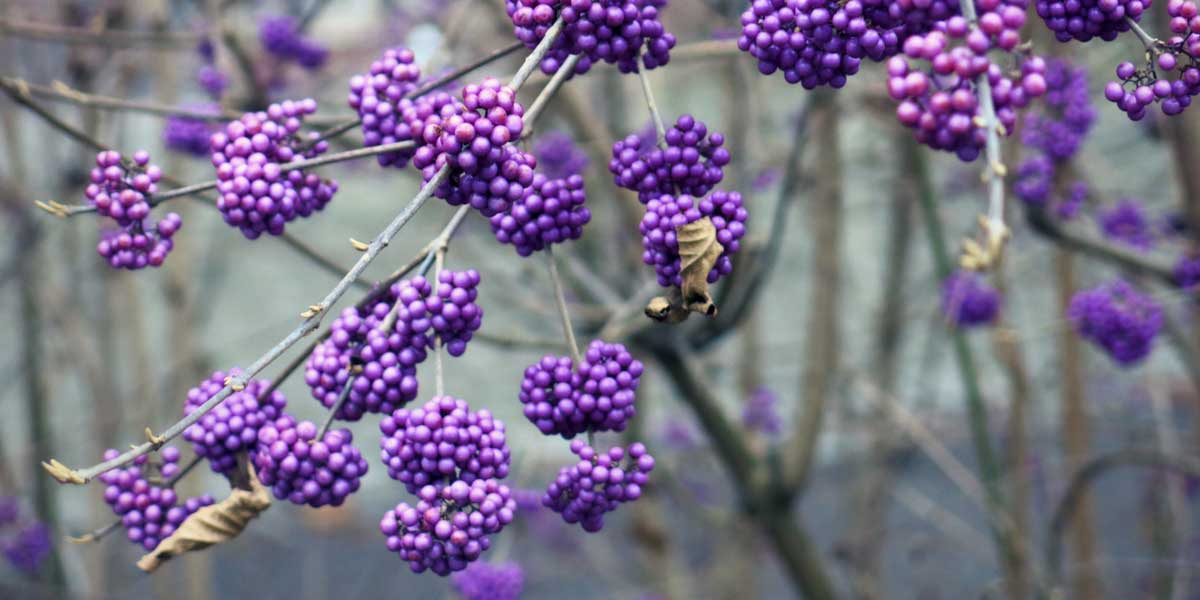
Care
The callicarpa is an easy-to-cultivate bush that requires very little maintenance. It is rarely diseased and practically never attacked by pests! We recommend installing a layer of mulch at its base to preserve soil moisture. Initially, it is best to water young callicarpa plants about once a week. As they mature, they become relatively drought-resistant. We also suggest adding some well-decomposed compost in spring, as callicarpa prefers fairly rich soils. During the first few years, you can protect it from the cold, especially if you are growing other species than Callicarpa bodinieri ‘Profusion’. Spring frosts are likely to damage young shoots. Callicarpa are more sensitive to cold when they are still young.
The callicarpa can easily do without pruning. However, you can carry out formative pruning during the first few years to give it a balanced and harmonious shape. In the following years, when the tree is older, you can perform maintenance pruning. Remove damaged, poorly formed, or poorly positioned branches. Pruning the callicarpa will also help contain its growth to maintain a compact habit, which is beneficial if your garden is small. Intervene in early spring, around April.
Propagating
It is possible to propagate callicarpa by sowing or by propagation by cuttings. We recommend propagation by cuttings to ensure that you obtain a variety identical to the original plant. Sowing should be reserved for botanical species.
Sowing
Callicarpa is easy to propagate by sowing in spring or autumn. It is preferable to remove the pulp from the fruits to keep only the seeds. Allow them to dry and store them in a cool, dry place before sowing.
- Start by placing the seeds in water for 24 hours.
- Prepare a pot by filling it with a mixture of potting soil and sand.
- Sow the seeds.
- Gently firm down and water.
- Place the pot in a warm, bright location.
The substrate should remain moist until germination.
The seeds will take between two and three months to germinate. You can repot them, but we recommend keeping them in pots for a year before planting them in the garden.
Propagation by Cuttings
You can take semi-woody cuttings in summer.
- Fill a pot with potting soil mixed with a little sand.
- Take a stem about ten centimetres long from the tip of a healthy branch.
- Make a clean cut just below a node (the point where leaves attach to the stem).
- Remove the leaves at the base of the cutting. Keep only two leaves at the top.
- We recommend dipping the base of the stem in plant hormone to encourage rooting.
- Plant the cutting in the substrate.
- Firm around to eliminate air pockets and ensure good contact between the plant and the substrate.
- Water.
- It is best to place a plastic bag or a bottle over the pot to maintain a humid atmosphere. Ventilate occasionally to prevent the development of fungi or diseases.
- Place the pot in a warm, bright location but out of direct sunlight.
Ensure that the substrate remains moist until the cutting has rooted.
→ Learn more about the cutting technique for Callicarpa with Virginie’s tutorial!
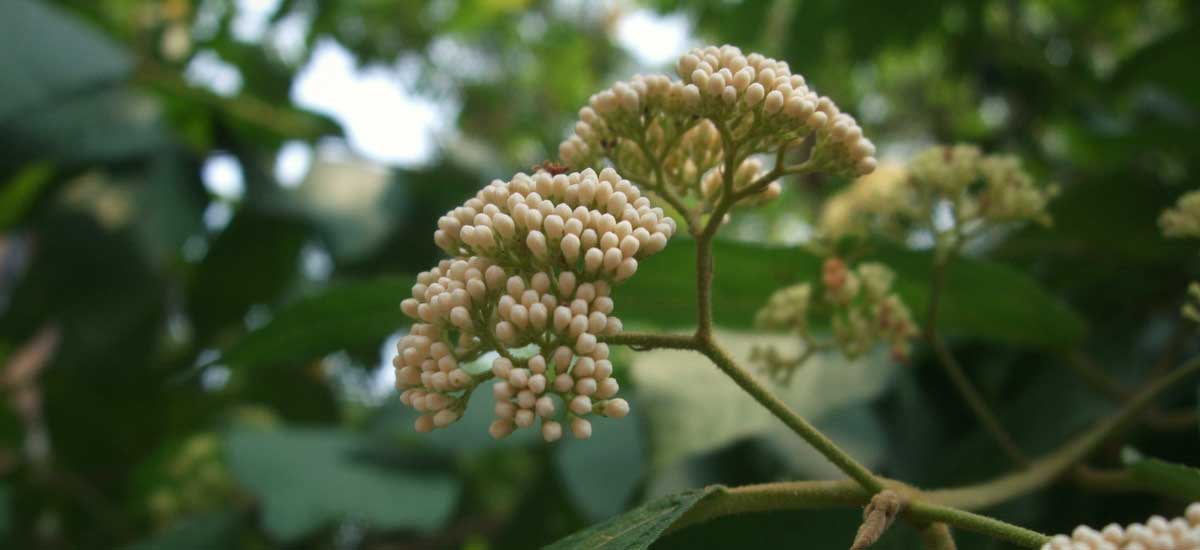
Callicarpa japonica ‘Leucocarpa’ (photo Shihchuan)
Associating
Callicarpa is perfect for creating a stunning autumn scene, in soft and warm tones, dominated by shades of purple, pink, mauve, violet, orange, and gold… You can draw inspiration from this atmosphere!
Pair it with autumn flowerings! You can place it alongside Persicaria amplexicaulis (for example, the variety ‘Pink Elephant’) or Sedum ‘Autumn Joy’. Some Asters also bloom until November, such as Aster novae-angliae ‘Herbstschnee’ or Aster divaricatus. To add brightness, choose rudbeckias (for example, Rudbeckia triloba), coreopsis, or chrysanthemums. If you live in a region with a mild climate, enjoy the vibrant flowering of Schizostylis coccinea. For lightness, you can add some grasses to your bed, such as pennisetum or miscanthus.
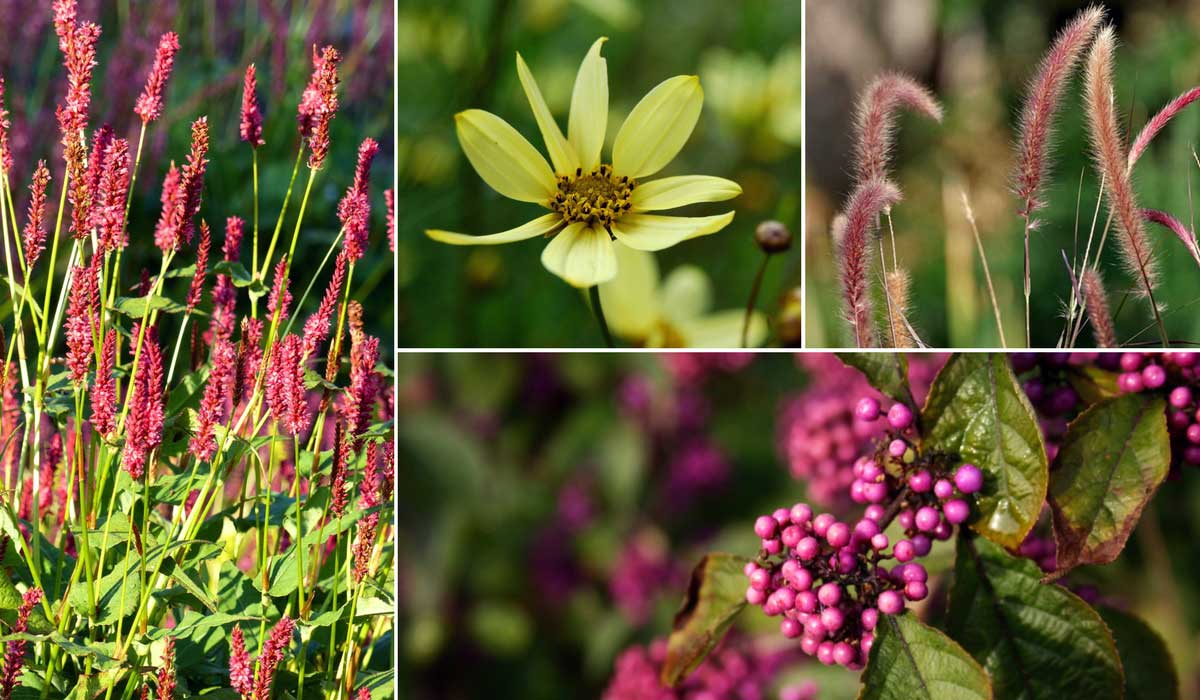
Pair your callicarpa with autumn flowerings! Persicaria amplexicaulis ‘JS Delgado’, Coreopsis verticillata ‘Moonbeam’, Pennisetum setaceum and Callicarpa bodinieri (photo Sten)
Integrate your callicarpa into a wild hedge, with other berry or decorative foliage shrubs. Many shrubs offer colourful and bright berries at the end of the year! For a soft combination, opt for symphorines with their pale pink or white berries. Enjoy the European spindle, Euonymus europaeus, which not only has decorative fruits but also stunning foliage in autumn! You can also create a beautiful contrast by pairing the purple berries of callicarpa with the orange ones from Pyracantha or sea buckthorn, Hippophae rhamnoides… Or with the red berries of cotoneasters! Don’t forget about the fruits of ornamental apple trees! Finally, you can place your callicarpa alongside the pheasant tree, Leycesteria formosa, whose berries remain decorative sometimes until late autumn.
Feel free to plant it with other shrubs whose leaves take on beautiful autumn colours: Acer palmatum, Viburnum, Cornus… Enjoy the fine and light foliage of heavenly bamboo, Nandina domestica, which turns red at the end of the year. Callicarpa also pairs very well with decoratively wooded shrubs, such as Cornus sanguinea or Cornus alba ‘Sibirica’! The purple berries will be perfect to accompany the red or orange wood of the dogwoods. Together, they create an intense and bright scene.
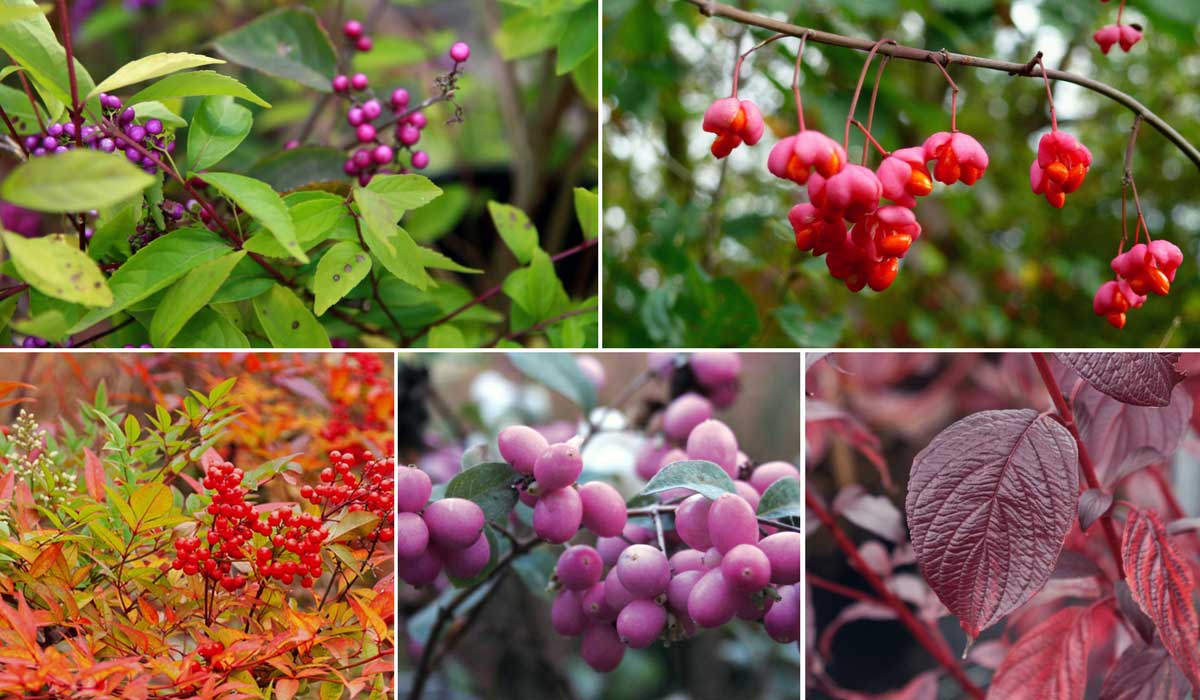
Callicarpa bodinieri ‘Profusion’ (Photo David J. Stang), Euonymus europaeus, Nandina domestica, Symphoricarpos ‘Magical Candy’ and Cornus alba ‘Siberian Pearls’
You can also plant them with other callicarpa! Don’t hesitate to gather different varieties, with different berry colours… For example, by pairing the purple berries of Callicarpa bodinieri ‘Profusion’ with the white berries of Callicarpa japonica ‘Leucocarpa’. By grouping callicarpa, you will enjoy a more abundant fruiting, as pollination will be facilitated.
Did you know?
- A callicarpa bonsai!
It is possible to train callicarpa as bonsai. You will achieve a truly spectacular dwarf bush in autumn! The most commonly used species is Callicarpa japonica.
Useful resources
-
- Discover our range of Callicarpa!
- Discover 5 ideas for pairing Callicarpa
- An article by Michael on our blog: The best ornamental bushes with decorative fruits
- Learn more about toxic berry plants
Frequently asked questions
-
My Callicarpa produces very few berries. Why?
The fruiting of callicarpa is less significant when they are planted in isolation, as they have difficulty self-fertilising. It is better to group them together to encourage pollination, thus increasing the chances of having plenty of berries! If your bush produces few fruits, this may also be due to a situation that is too shaded... It needs sunlight, and especially good brightness, to provide a generous flowering followed by numerous berries. Long, hot summers greatly favour fruiting. Finally, we recommend prioritising varieties such as Callicarpa bodinieri ‘Profusion’ or Callicarpa bodinieri ‘Imperial Pearl’, as their fruiting is more abundant than in other varieties.
-
My callicarpa is growing slowly and lacks vigour... What should I do?
Callicarpa prefers relatively rich soils, which is why we recommend adding compost in spring. Additionally, overly compacted ground can limit the growth of the bush. It is best to plant it in light, airy soil, or to add draining materials during planting: gravel, coarse sand, pumice... Finally, you can also carry out pruning at the beginning of spring to stimulate its growth.
- Subscribe!
- Contents
. Callicarpa, the Candy Tree: Planting, Pruning, and Care](https://en.promessedefleurs.eu/blogwp/wp-content/uploads/2018/10/callicarpa-_-tout-savoir.jpg)































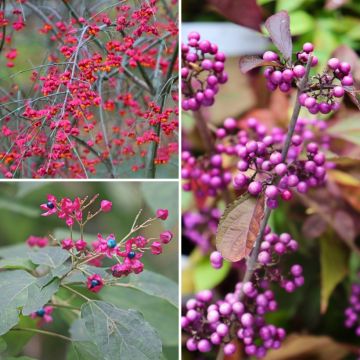
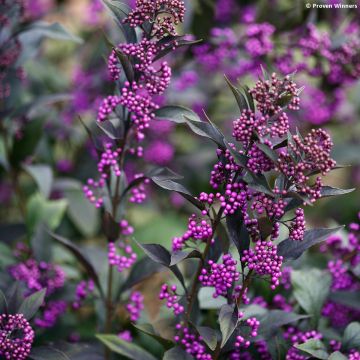
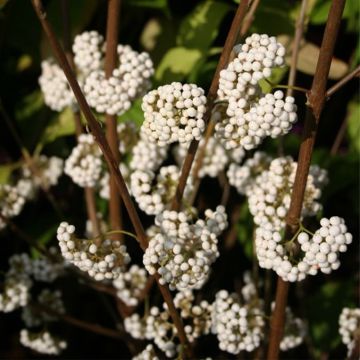



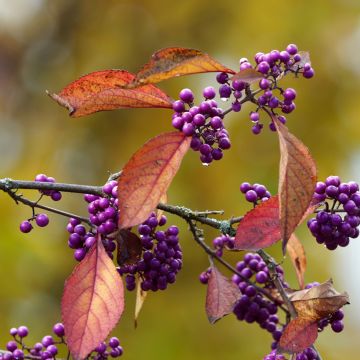
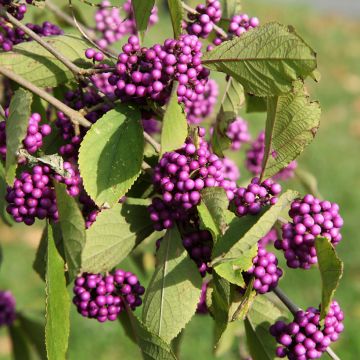

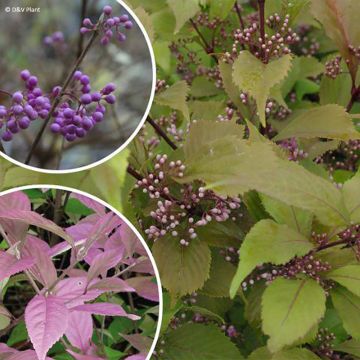
Comments